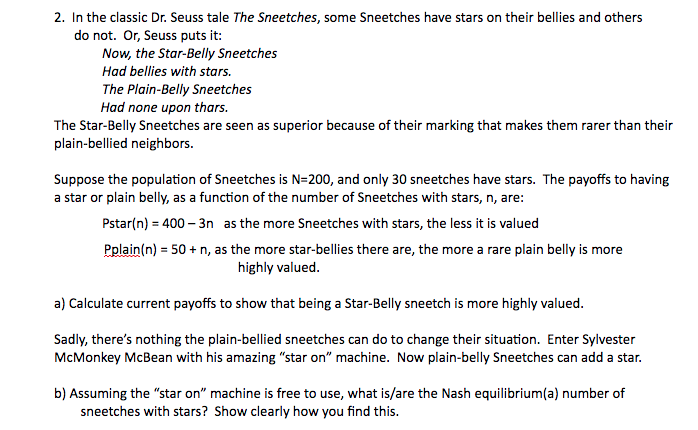Answered step by step
Verified Expert Solution
Question
1 Approved Answer
2. In the classic Dr. Seuss tale The Sneetches, some Sneetches have stars on their bellies and others do not. Or, Seuss puts it:

2. In the classic Dr. Seuss tale The Sneetches, some Sneetches have stars on their bellies and others do not. Or, Seuss puts it: Now, the Star-Belly Sneetches Had bellies with stars. The Plain-Belly Sneetches Had none upon thars. The Star-Belly Sneetches are seen as superior because of their marking that makes them rarer than their plain-bellied neighbors. Suppose the population of Sneetches is N=200, and only 30 sneetches have stars. The payoffs to having a star or plain belly, as a function of the number of Sneetches with stars, n, are: Pstar(n) = 400-3n as the more Sneetches with stars, the less it is valued Pplain(n) = 50+ n, as the more star-bellies there are, the more a rare plain belly is more highly valued. a) Calculate current payoffs to show that being a Star-Belly sneetch is more highly valued. Sadly, there's nothing the plain-bellied sneetches can do to change their situation. Enter Sylvester McMonkey McBean with his amazing "star on" machine. Now plain-belly Sneetches can add a star. b) Assuming the "star on" machine is free to use, what is/are the Nash equilibrium(a) number of sneetches with stars? Show clearly how you find this.
Step by Step Solution
★★★★★
3.57 Rating (157 Votes )
There are 3 Steps involved in it
Step: 1
a The current payoffs can be calculated simply by plugging in n 30 Pstar 400 3n 4...
Get Instant Access to Expert-Tailored Solutions
See step-by-step solutions with expert insights and AI powered tools for academic success
Step: 2

Step: 3

Ace Your Homework with AI
Get the answers you need in no time with our AI-driven, step-by-step assistance
Get Started


